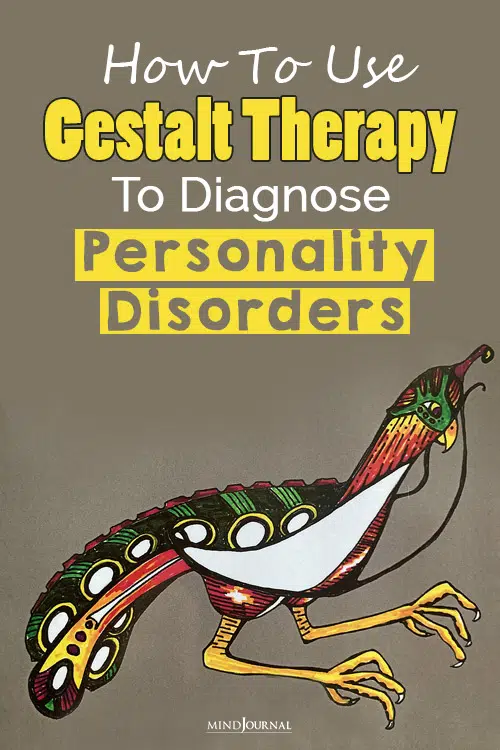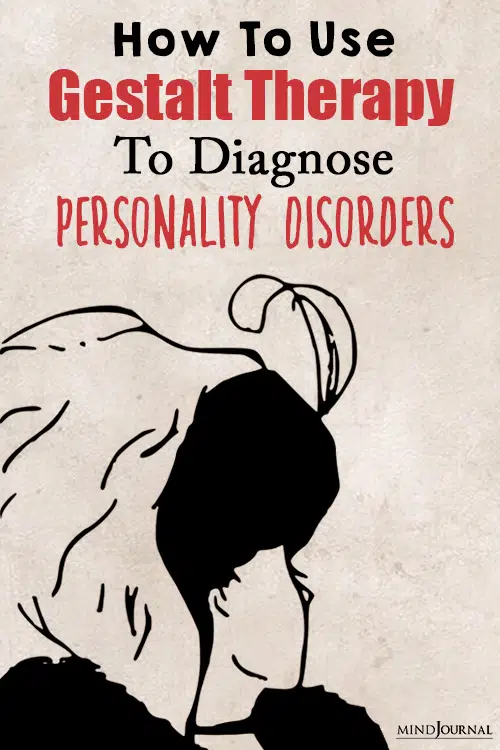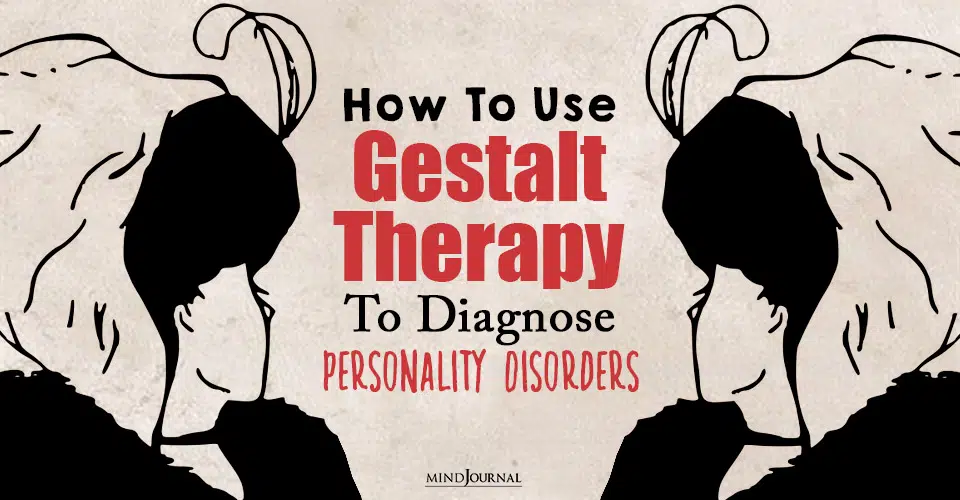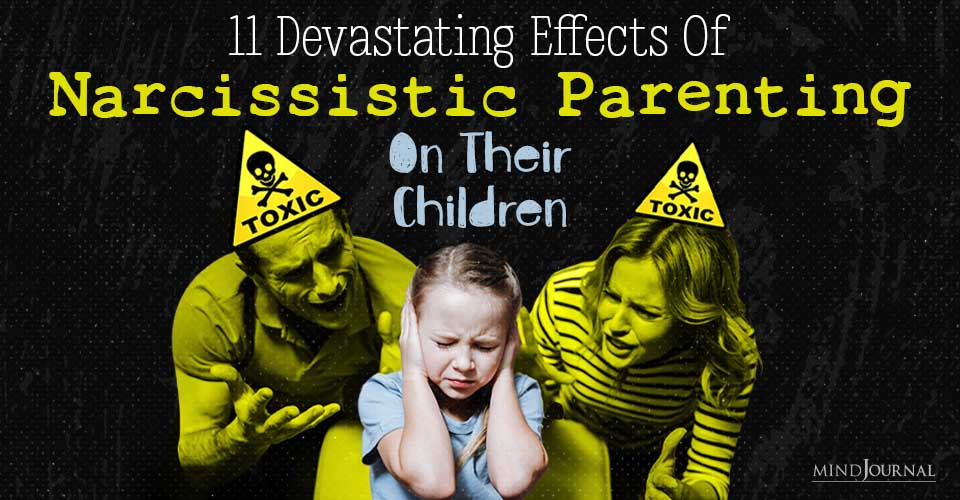How To Use Gestalt Therapy To Diagnose Personality Disorders? What people need, want, and fear reveals their diagnosis.
Written By: Elinor Greenberg
KEY POINTS
- People with personality disorders are still preoccupied with their unmet interpersonal needs and problems from childhood.
- They unconsciously project these desires, fears, and needs onto their current adult relationships.
- The Interpersonal Gestalt describes what people notice and what they ignore in interpersonal situations.
One of the difficulties that clients face when looking for a psychotherapist to diagnose and treat their personality disorder is that so few therapists actually have the necessary training to do so. This is mainly because the traditional methods of teaching this topic involve many years of study with difficult-to-understand experts who write in obscure professional jargon.
In an effort to encourage more psychotherapists to learn about the differential diagnosis of borderline, narcissistic, and schizoid disorders, I have developed a simplified way to make these diagnoses that is based on the Gestalt therapy theory. It is easy to understand and can also be used informally by observant non-mental health professionals. I call it “The Interpersonal Gestalt” (1999).
This method has its limitations because it relies on what can be observed across multiple interpersonal interactions and on the awareness of the observer. However, I have taught it to many psychotherapists who find it a useful introduction to a difficult subject. It can be supplemented by using more conventional diagnostic systems if the need arises.
What Is The Interpersonal Gestalt?
My concept of the Interpersonal Gestalt is based on the Gestalt Psychology theory of Figure/Ground formation (Wagemans, Elder, Kubovy, et al, 2012). This basically states that at any point in time, there is more data available to our mind and senses than we can possibly process. Therefore, we automatically prioritize certain types of data over other types. In interpersonal encounters, we tend to make an organized whole—a figure—out of cues that relate to our current desires, needs, and fears. Everything else becomes part of the invisible background.
Gestalt is a German word that refers to an organized whole that is more (or different) than simply the sum of its parts. For example, a melody is perceived as an organized whole and not just a series of musical notes. Its effect on us emotionally cannot be predicted simply from the individual notes.
Read How Much Of A Psychopath Are You? Take This Unique Visual Test To Know!
How Does This Relate To Diagnosis?
If we had a good enough childhood, most of us are able to relate to other people in a fairly spontaneous, flexible way. We are open to the actual person and situation in front of us. However, if we have a personality disorder, we tend to automatically and unconsciously project our old unmet needs and fears from our childhood onto the new situation. We may misread the current situation and the other person’s intentions because most of what we are noticing is based on our past. Other potentially important interpersonal cues become part of the unseen background.
As a result, we can distinguish the three major personality disorders—borderline, narcissist, and schizoid—from each other by what the person repeatedly notices or ignores during interpersonal encounters. As you can see below, the primary desires and fears of people with borderline, narcissistic, or schizoid disorders are quite different from one another.
1) Borderline Interpersonal Gestalt –
Desires:
Unconditional love, nurturing and reparenting.
Fears:
Abandonment, rejection as unlovable, or engulfment by the emotional needs of the other person.
Read 10 Common Symptoms Of Borderline Personality Disorder (BPD)
2) Narcissistic Interpersonal Gestalt
Desires:
Self-esteem enhancement, admiration, attention, increase in social status.
Fears:
Loss of self-esteem, being exposed as imperfect, public humiliation, and diminished status.
3) Schizoid Interpersonal Gestalt
Desires:
Safe intimacy, independence, predictability, and control over interpersonal distance.
Fears:
Loss of autonomy, intrusiveness, loss of the ability to connect, existential dread.
So What’s The Difference Between Borderline, Narcissistic, And Schizoid Personally Disorders?
Let’s look at how this method of diagnosis might play out during a first session, based on what three different clients makes figural about me and my office.
Example 1: Emma
Emma shows up for her first session beautifully dressed in designer clothing. She looks around the room, looks at my wall of diplomas, and points to my floor-to-ceiling bookcase. “Very impressive,” she says. “How many of these books have you actually read?”
I say: “About a third of them. I use them for references on an as-needed basis.”
Next, she tries to gather financial information about me: “This office is very nice. Do you rent or …?”
By the time we begin the session, I feel as if I have just passed a series of tests about my intelligence, credentials, wealth, and status.
So what was figural for Emma?
This brief snippet is too short to give Emma a definitive diagnosis, but we can get important information from what she found interesting and remarked on.
Status:
Emma was wearing high-status clothing and noticed things that seemed to indicate my professional, intellectual, and personal social status:
- My diplomas—indicators of professional status.
- My wall of books—indicators of my professional and intellectual status.
- Whether I rented my office or owned it—indicators of my financial and social status.
Read Dissociative Identity Disorder: Everything You Need To Know About DID
Example 2: Ben
Ben arrives exactly on time. He comes in and asks: “Where should I sit?” I sit down in my chair and suggest that he sit wherever he likes. He chooses the chair closest to the exit and not in my direct line of vision. He appears visibly nervous.
I ask: “What brings you here today?”
He says: “I am very unhappy at work. They changed my office and now I am sitting in an open area. I have no privacy, no control over my space, and anyone can approach me and start talking anytime they want. This is my worst nightmare.”
I ask: “How are you feeling about where you are sitting in relation to me? Are you where you want to be?”
Ben says: “I am not sure. No one has ever asked me about my seating preferences before or even checked how I felt! I like that you sat down first. I like knowing where other people are. I like things to be predictable and that you gave me a choice of seats. I chose the one nearest the door so I could run out of here quickly, if I wanted to leave.“
So what was figural for Ben?
Control over interpersonal access
Ben was focused on issues that had to do with privacy, intrusiveness, physical proximity to others, and the ability to quickly escape an interpersonal situation.
- The new open seating plan at work.
- Knowing in advance where I would sit.
- Having a choice for the first time.
- Diminishing intimacy by being out of my direct line of sight.
- Being near the door.
Example 3: Suzi
Suzi came for her first session 10 minutes late. She was very, very apologetic. I found myself reassuring her a bit like you might reassure a child that you were not angry.
I invited her to sit and she went to the velvet sofa that had soft pillows and a granny afghan. She took off her shoes, gathered up some pillows, and curled up on the sofa.
Suzi said: “This is a beautiful office—so warm and inviting. The afghan reminds me of my Granny. I loved her so much. She was so kind! She let me play with anything I wanted and she always had my favorite foods. You remind me of her. You are so nice to me. I am already comfortable here with you.”
So what was figural for Suzi?
Indicators of warmth and caring
Suzi focused on issues that related to love and acceptance by me
- Her lateness and concern about my reaction.
- The warmth and beauty of my office.
- The afghan that reminded her of her beloved granny.
- My “niceness.”
- How comfortable she was with me.
- My similarities to someone who had unconditionally loved Suzi.
Using The Interpersonal Gestalt As A Beginning Place To Start Diagnosing The Person
Obviously, I do not have enough information here to make a diagnosis. But paying close attention to what Emma, Ben, and Suzi each made figural (and what they did not) during our first meeting makes it clear that they have very different issues and are likely to have very different diagnoses.
What Personality Disorders Do These Initial Interpersonal Responses Suggest?
Emma and status:
Emma’s focus on aspects of the room that relate to status and her cool evaluation of me, suggests that, if she does have a personality disorder, it is likely to be a narcissistic one.

Ben and interpersonal distance:
Ben made it clear that he felt unsafe when he could not control other people’s physical access to him. This is a common concern that is expressed by almost all my clients who have made schizoid adaptations. I planned to keep his concerns about interpersonal safety in mind and explore the possibility that he had a schizoid personality disorder.
Suzi and her Granny:
Suzi had none of Ben’s hesitations about closeness and seemed unconcerned with the items that might signal my status that was so important to Emma. Instead, Suzi focused on things about me and the office that related to warmth, love, and caring.
This focus is typical of my borderline clients, as is her willingness to take her shoes off and curl up on the sofa. I remind her of her loving permissive Granny and she reminds me of my 4-year-old grandchild—who also likes to curl up on my sofa without her shoes, clutching the afghan with her head on a mound of pillows.
Read How Schizoid Personality Disorder Interferes With Intimate Relationships
Summary
The concept of the Interpersonal Gestalt can help psychotherapists fairly quickly recognize those clients who may need help with a personality disorder. Each of the three main personality disorders can be differentiated from each other by noticing the type of interpersonal data they focus on and what they ignore.
References: Greenberg, E. (1999). Love, Admiration, and Safety: A Gestalt Therapy System for the Diagnosis of Borderline, Narcissistic, and Schizoid Adaptations, Studies in Gestalt Therapy, 8, 52-64. Wagemans J, Elder JH, Kubovy M, et al. A century of Gestalt psychology in visual perception: I. Perceptual grouping and figure-ground organization. Psychol Bull. 2012;138(6):1172-217. doi:10.1037/a0029333 Cherry, K. (2021). What is Gestalt Psychology? https://www.verywellmind.com/what-is-gestalt-psychology-2795808
Originally Appeared On: Psychology Today
Republished with permission










Leave a Reply
You must be logged in to post a comment.